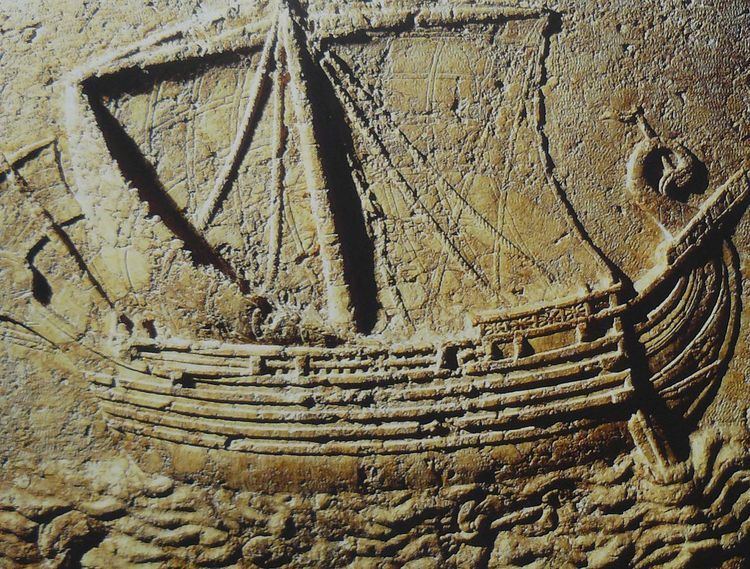 | ||
The theory of Phoenician discovery of the Americas suggests that the earliest Old World contact with the Americas was not with Columbus or Norse settlers, but with the Phoenicians (or, alternatively, other Semitic peoples) in the first millennium BC.
Contents
Before the 20th century
This theory of a Phoenician discovery of the Americas was popular in the 18th and 19th centuries. In the late 18th century, a number of people speculated on the origins of the petroglyphs on Dighton Rock. Ezra Stiles, then President of Yale College, believed them to be Hebrew. Antoine Court de Gébelin, who initiated the modern usage of the Tarot, argued in Le Monde primitif that they commemorated an ancient visit to the Massachusetts shore by a group of sailors from Carthage.
In the 19th century, belief in an Israelite visit to the Americas became a part of Mormonism. Ross T. Christensen has propounded the theory that the Mulekites in the Book of Mormon were "largely Phoenician in their ethnic origin."
In his 1871 book Ancient America, John Denison Baldwin said
The known enterprise of the Phoenician race, and this ancient knowledge of America, so variously expressed, strongly encourage the hypothesis that the people called Phoenicians came to this continent, established colonies in the region where ruined cities are found, and filled it with civilized life. It is argued that they made voyages on the “great exterior ocean,” and that such navigators must have crossed the Atlantic; and it is added that symbolic devices similar to those of the Phoenicians are found in the American ruins, and that an old tradition of the native Mexicans and Central Americans described the first civilizers as “bearded white men,” who “came from the East in ships.”
In the 1870s, a stone inscription was allegedly discovered in Paraíba, Brazil. A transcription was shown to Ladislau de Souza Mello Netto, director of the National Museum of Brazil. Netto accepted the inscription as genuine, but when it was later stated to be a hoax, Netto backed down and blamed foreigners for its fabrication. In the 1960s, Cyrus H. Gordon believed the inscription to be genuine and created a translation which begins, "We are Sidonian Canaanites from the city of the Mercantile King ..." The inscription's letter forms are variations that individually occurred and disappeared over a span of 800 years and so the confluence in a single piece of writing verifies the inscription as a hoax.
20th century theories
In the 20th century, adherents have included Cyrus H. Gordon, John Philip Cohane, Ross T. Christensen, Barry Fell and Mark McMenamin. Gordon believed that ancient Hebrew inscriptions had been found at two sites in the southeastern United States, indicating that Jews had arrived there before Columbus. One of these supposed finds was the Bat Creek inscription, which Gordon believed to be Paleo-Hebrew, but is generally thought to be a forgery. Another find which has been claimed as supporting the theory of Semitic discovery of the Americas is the Los Lunas Decalogue Stone, which has also been dismissed as a fake.
In 1996, Mark McMenamin proposed a theory that Phoenician sailors discovered the New World c. 350 BC. The Phoenician state of Carthage minted gold staters in 350 BC bearing a pattern, in the reverse exergue of the coins, which McMenamin interpreted as a map of the Mediterranean with the Americas shown to the west across the Atlantic. McMenamin later demonstrated that putative Carthaginian coins found in America were modern forgeries.
Various theories of Phoenicians/Canaanites/Carthaginians in the New World were discussed, the evidence reviewed and dismissed by Marshall McKusick in The Biblical Archaeologist, 1979; he observed "in this modern day everyone wishes to be his own authority, and the personal search for cultural alternatives seems to make every idea or theory equal in value."
21st century theories
Lucio Russo finds evidence in favour of a probable arrival of Phoenicians in the Americas in his philologic analyses of Ptolemy's Geography given in L'America dimenticata. In his book Ptolemy gives the coordinates of the Fortunate Isles but at the same time he shrinks the size of the world by one third compared to the size measured by Eratosthenes. Russo observes that by attributing those coordinates to the Antilles, the world gets back to the right size, the geographical description given by Ptolemy fits much better and certain puzzling deformations in Ptolemy's world map disappear. Russo argues that the Antilles coordinates must have been known to Ptolemy source, which was Hipparcos. Hipparcos lived in Rhodes and may have got this information from Phoenicians sailors, since they had full control of the western Mediterranean in those times.
Scholarly assessment
Glenn Markoe says that it will "probably never be known" whether the Phoenicians ever reached the Americas. He remarks,
Proof in the form of an inscription, like the celebrated Phoenician text allegedly found in Paraíba in northern Brazil, remains unlikely. The latter, which recounts the landing of a storm-driven party from Sidon, has long been recognized as a clever forgery. If such a fateful expedition had actually occurred, the proof is more likely to be found in a handful of Phoenician pottery shards.
Ronald H. Fritze discusses the history of such claims from the 17th to the 20th centuries, concluding that although technically possible:
no archaeological evidence has yet been discovered to prove the contentions of Irwin, Gordon, Bailey, Fell and others. Since even the fleeting Norse presence in Vinland left definite archaeological remains at L’Anse aux Meadows in Newfoundland, it seems logical that the allegedly more extensive Phoenician and Carthaginian presence would have left similar evidence. The absence of such remains is strong circumstantial evidence that the Phoenicians and Carthaginians never reached the Americas.
